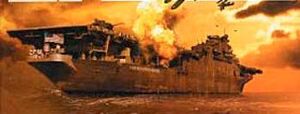
For the US political and cultural movement before and during the Great War, see Remembrance (Political Ideology)
The USS Remembrance was the world's first airplane carrier. It was built, commissioned, and operated by the U.S. Navy.
The Remembrance was commissioned immediately after the conclusion of the Great War at the Boston Navy Yard. She was initially built as a lightly-armored battle cruiser, described as "a monitor with legs", and designed to raid the Confederate coast by hitting targets with its firepower and then quickly slipping away before any retaliation could be launched. While one-third complete, construction of the Remembrance was halted by the War Department and, upon its incomplete hull, a full-length flight deck was built with a superstructure, called an "island", erected amidships and offset on the starboard side. As the world's very first airplane carrier, the Remembrance was considered a state-of-the-art vessel; from its original design, it retained its 5-inch guns in a gallery of sponsons below the flight deck for offensive firepower and featured a complement of nearly three dozen Wright two-decker fighting scouts.
In 1920–21, under the command of Captain Oliver Roland, she aided the Irish government in putting down a British-backed uprising in the northern counties, demonstrating to the world the offensive capabilities of an airplane carrier. During the 1920s, under Socialist President Upton Sinclair, the Remembrance languished in the Boston Navy Yard before being sent to the Pacific Ocean in 1928. Thereafter the ship played a more important role in naval history. She was nearly sunk in 1932 by a Japanese submersible while she was patrolling the Canadian coastline against Japanese arms smugglers. This incident and Japan's covert support for Canadian rebels touched off the Pacific War between the United States and Japan. During the conflict, now under the command of Captain Stein, the Remembrance participated in the first naval battles where neither side's ships saw one another. After the war's uneventful end in 1934 she was transferred to the Atlantic Ocean, where she was outfitted with wireless-ranging (a.k.a. Y-range) gear in 1940.
When the Confederate States declared war on June 22, 1941 by bombing Philadelphia, the Remembrance was ordered to launch a retaliatory airstrike on Charleston, South Carolina. Despite sustaining considerable damage from CS aircraft, the ship accomplished its mission, retiring to US-controlled Bermuda for repairs. However, this success was overshadowed when HMS Ark Royal managed to lure the carriers Remembrance and USS Sandwich Islands away from Bermuda, allowing a joint C.S./British task force to take the strategically important island.
When it became clear that the Bahamas would fall too, the Remembrance was ordered to the Pacific to face Japan, becoming the sole U.S. Navy carrier in that ocean. On December 7, 1941, she was ordered to relieve Midway Island and, despite sinking one Japanese carrier and damaging another in the battle, was struck twice on the bow by Japanese bombs, then hit once more in the stern near the ship's gasoline stores. In spite of the heroic efforts of Sam Carsten and his damage-control parties, the resulting fires led to the ship's sinking. Captain Stein went down with her, though Carsten and the executive officer Daniel Cressy both survived. Remembrance's loss ensured Midway's fall to Japan and forced the U.S. Navy to restrict its operations under land-based aircover until the next year when more carriers could be sent to the Pacific.
Crew members
- Oliver Roland, Commanding Officer (early 1920s)
- Captain Stein†, Commanding Officer (c. 1930 - 1941)
- Daniel Cressy, Executive Officer (c. 1930 - 1941)
- Hiram Pottinger†, Damage Control Head (1932 - 1941)
- Sam Carsten, Damage Control Officer (1928 - 1941)
- "Eyechart" Szczerbiakowicz†, Damage Control (late 1930s - 1941)










